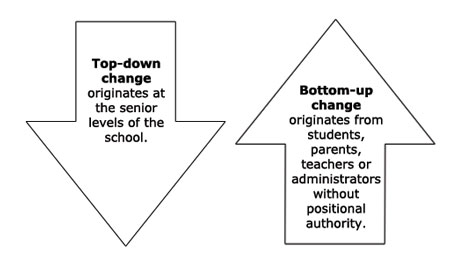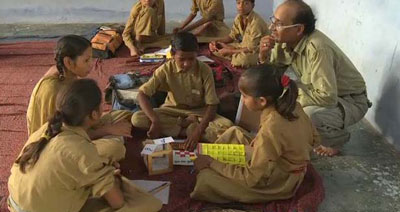3 How change happens
Several views have been presented on how change comes about in our schools and educational settings. One such argument is the notion of internally versus externally initiated change. By internally initiated change we consider all students, teachers and administration staff as potential change agents who, through their work, are able to initiate and implement change (mainly owing to the need to improve on quality and standards). This is often described as the voluntarist view, because the emphasis is on how the voluntary (or self-initiated) actions of leaders and other change agents bring about change within the school.
Another view is that most educational change is externally initiated. This is characterised by pressures from education authorities as new policies are introduced. This is often referred to as the deterministic view, because it sees leaders and their staff as targets of a change that is determined by external forces (economics, technology, globalisation, culture shift, etc.). Many teachers and school leaders say that they often experience this kind of change where the requirement to change is demanded or enforced.
Change in the school context refers to any form of change that takes place in the school, whether it is deliberate action by staff or students to change the status quo, or is a state or national initiative. The change could be proactive (a deliberate, self-initiated action) or reactive (responding to a stimulus).
Regardless of whether it is internally or externally driven, there are two ways of looking at how change is actually initiated within a school (Figure 2).
Figure 2 Top-down and bottom-up change.
Top-down change can be seen as relatively easy and straightforward to put into practice across the school, provided it is negotiated and agreed by staff and SMC members – which is not always the case. It usually takes a school-wide approach, and so has the advantage of promoting a consistent, systematic approach to the change at hand. Top-down change usually involves some degree of consultation with those implementing the change; however, particularly in times of crisis, top-down change can be imposed in a directive and coercive way without staff consultation. This may have severe consequences for motivation and morale, but if organisational survival is at stake, school staff may well accept the need for rapid and drastic action without a consultation process.
Bottom-up change, on the other hand, has the advantage of being designed by the school community itself. This is mandated by the RtE, wherein SMCs are to develop, implement and monitor plans, and then promote it across the school. Bottom-up change may also be suggested by anyone in the school, but then implemented by senior staff who have the authority to influence and drive it through. However, it often requires a high degree of negotiation, and a school community may not readily agree on a change; so it raises other challenging issues. For this reason, bottom-up change is sometimes considered to be unpredictable and it takes time for it to be adopted across the organisation.
Figure 3 Listening to students’ ideas.
To minimise problems in any change initiative, some school leaders implement their change in one area of the school as a pilot scheme to try out new ways of working, assess problems and issues that arise, and make any necessary adjustments before rolling it out across the whole school. This means that any major weaknesses can be sorted before introducing the change on a larger scale.
Activity 2: Changes in your school
Spend some time thinking of three significant changes that have taken place in your school in the last year or two. They might be large or small changes, but they will have meant that people had to change their priorities, behaviours or processes. In your Learning Diary, make notes related to the following questions:
- What was the driver or initiator for each change?
- How did you and others respond to that driver?
- What were the challenges of implementing the change?
- How did you and your colleagues cope with the change?
- What has been the impact of the change on student learning?
Discussion
Educational change initiatives can embrace a broad range of issues: classroom practice, school-level change or larger-scale transformation at state or national level. Your own response will vary from that of other school leaders, because change affects everyone differently. Some colleagues may have a wealth of experience of change; others may be witnessing it for the first time. While some may be anxious about change and their role, others may seize the opportunity to steer and influence.
The examples in Case Studies 1 and 2 are typical of bottom-up change. Although external stakeholders were involved in the success story reported at New Shishu Public School, the change was started by school leaders who recognised and addressed a local problem.
It is preferable to get buy-in or agreement from all stakeholders in any change initiative. However, you may find yourself in a situation where not everyone shares your view of the future. For this reason, your approach to any change is crucial. You will consider some of these issues in Section 6.
There are therefore three important things to bear in mind when leading or managing change:
- There is an element of uncertainty: no one knows what the future holds, but reasonable plans can be put in place to reach the future goal.
- Change requires leadership: someone, or a group of people, who may not necessarily be a leader by job description but who takes control and provides direction throughout the change period.
- Change has an emotional impact: it affects people differently and they react in different ways – some negative, some positive.
But is change always good? Some may argue that minimal change is necessary for sustainability, and would therefore consider stability and change as opposites. One could also argue that stability and change are interdependent, as they are both necessary in a world that is changing at great speed. Without change, an organisation could become obsolete. Schools may find that change is necessary to respond to external changes such as migration, new technologies, poverty, gender imbalance, employment skills deficits, etc.
In a changing external environment, internal change is required for the organisation to appear to stay the same and maintain stability in its community and wider context. For example, a school with an increasing migrant population may have to change some of its practices and processes to accommodate the different cultures that constitute the student population. If it does not change, segregation, intimidation and tension among students and staff could arise.
In the sections that follow, you will look at school-level change and begin to consider how you, as a school leader, can work with your staff to bring about change. You will also consider some ways in which you can overcome barriers to change and foster an environment that allows others to try new approaches.
2 Dealing with challenges


